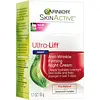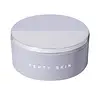What's inside
What's inside
 Key Ingredients
Key Ingredients

 Benefits
Benefits

 Concerns
Concerns

 Ingredients Side-by-side
Ingredients Side-by-side

Water
Skin ConditioningGlycerin
HumectantIsohexadecane
EmollientIsopropyl Isostearate
EmollientAluminum Starch Octenylsuccinate
AbsorbentNylon-12
Octyldodecanol
EmollientCetyl Alcohol
EmollientBehenyl Alcohol
EmollientAdenosine
Skin ConditioningAmmonium Polyacryloyldimethyl Taurate
Emulsion StabilisingArachidyl Alcohol
EmollientBenzyl Alcohol
PerfumingC13-14 Isoparaffin
EmollientCaprylic/Capric Triglyceride
MaskingCapryloyl Salicylic Acid
ExfoliatingCetearyl Alcohol
EmollientCetearyl Glucoside
EmulsifyingCI 77891
Cosmetic ColorantDisodium EDTA
Glycine Soja Protein
EmulsifyingHydrolyzed Rice Protein
Skin ConditioningLaureth-7
EmulsifyingLinalool
PerfumingMethylisothiazolinone
PreservativeMethylparaben
PreservativeMica
Cosmetic ColorantPalmitic Acid
EmollientPEG-100 Stearate
Phenoxyethanol
PreservativePolyacrylamide
Polyethylene
AbrasiveRetinyl Linoleate
Skin ConditioningSodium Acrylates Copolymer
Sodium Benzoate
MaskingSodium Hyaluronate
HumectantStearic Acid
CleansingStearyl Alcohol
EmollientParfum
MaskingWater, Glycerin, Isohexadecane, Isopropyl Isostearate, Aluminum Starch Octenylsuccinate, Nylon-12, Octyldodecanol, Cetyl Alcohol, Behenyl Alcohol, Adenosine, Ammonium Polyacryloyldimethyl Taurate, Arachidyl Alcohol, Benzyl Alcohol, C13-14 Isoparaffin, Caprylic/Capric Triglyceride, Capryloyl Salicylic Acid, Cetearyl Alcohol, Cetearyl Glucoside, CI 77891, Disodium EDTA, Glycine Soja Protein, Hydrolyzed Rice Protein, Laureth-7, Linalool, Methylisothiazolinone, Methylparaben, Mica, Palmitic Acid, PEG-100 Stearate, Phenoxyethanol, Polyacrylamide, Polyethylene, Retinyl Linoleate, Sodium Acrylates Copolymer, Sodium Benzoate, Sodium Hyaluronate, Stearic Acid, Stearyl Alcohol, Parfum
Water
Skin ConditioningGlycerin
HumectantCaprylic/Capric Triglyceride
MaskingDicaprylyl Carbonate
EmollientGlycereth-26
HumectantNiacinamide
SmoothingHyaluronic Acid
HumectantSodium Hyaluronate
HumectantPanthenol
Skin ConditioningTocopheryl Acetate
AntioxidantCitrullus Lanatus Seed Oil
EmollientBackhousia Citriodora Leaf Extract
AstringentCereus Grandiflorus Flower Extract
Skin ConditioningHovenia Dulcis Fruit Extract
Skin ConditioningAdansonia Digitata Seed Oil
EmollientAdansonia Digitata Fruit Extract
EmollientCamellia Sinensis Leaf Extract
AntimicrobialAloe Barbadensis Leaf Juice
Skin ConditioningSimmondsia Chinensis Seed Oil
EmollientTocopherol
AntioxidantPhospholipids
Skin ConditioningHydrolyzed Jojoba Esters
Skin ConditioningCetearyl Glucoside
EmulsifyingGlyceryl Caprylate
EmollientGlyceryl Undecylenate
EmollientPolyglyceryl-3 Methylglucose Distearate
EmulsifyingHydroxyethyl Acrylate/Sodium Acryloyldimethyl Taurate Copolymer
Emulsion StabilisingCetearyl Alcohol
EmollientAmmonium Acryloyldimethyltaurate/Beheneth-25 Methacrylate Crosspolymer
Emulsion StabilisingPentaerythrityl Tetra-Di-T-Butyl Hydroxyhydrocinnamate
AntioxidantPolysorbate 60
EmulsifyingSorbitan Isostearate
EmulsifyingSodium Phytate
Xanthan Gum
EmulsifyingCitric Acid
BufferingLeuconostoc/Radish Root Ferment Filtrate
AntimicrobialHydroxyacetophenone
AntioxidantPropanediol
SolventButylene Glycol
HumectantEthylhexylglycerin
Skin ConditioningPhenoxyethanol
PreservativeParfum
MaskingBenzyl Salicylate
PerfumingHexyl Cinnamal
PerfumingLinalool
PerfumingLimonene
PerfumingCI 14700
Cosmetic ColorantCI 17200
Cosmetic ColorantWater, Glycerin, Caprylic/Capric Triglyceride, Dicaprylyl Carbonate, Glycereth-26, Niacinamide, Hyaluronic Acid, Sodium Hyaluronate, Panthenol, Tocopheryl Acetate, Citrullus Lanatus Seed Oil, Backhousia Citriodora Leaf Extract, Cereus Grandiflorus Flower Extract, Hovenia Dulcis Fruit Extract, Adansonia Digitata Seed Oil, Adansonia Digitata Fruit Extract, Camellia Sinensis Leaf Extract, Aloe Barbadensis Leaf Juice, Simmondsia Chinensis Seed Oil, Tocopherol, Phospholipids, Hydrolyzed Jojoba Esters, Cetearyl Glucoside, Glyceryl Caprylate, Glyceryl Undecylenate, Polyglyceryl-3 Methylglucose Distearate, Hydroxyethyl Acrylate/Sodium Acryloyldimethyl Taurate Copolymer, Cetearyl Alcohol, Ammonium Acryloyldimethyltaurate/Beheneth-25 Methacrylate Crosspolymer, Pentaerythrityl Tetra-Di-T-Butyl Hydroxyhydrocinnamate, Polysorbate 60, Sorbitan Isostearate, Sodium Phytate, Xanthan Gum, Citric Acid, Leuconostoc/Radish Root Ferment Filtrate, Hydroxyacetophenone, Propanediol, Butylene Glycol, Ethylhexylglycerin, Phenoxyethanol, Parfum, Benzyl Salicylate, Hexyl Cinnamal, Linalool, Limonene, CI 14700, CI 17200
Ingredients Explained
These ingredients are found in both products.
Ingredients higher up in an ingredient list are typically present in a larger amount.
This ingredient is an emollient, solvent, and texture enhancer. It is considered a skin-softener by helping the skin prevent moisture loss.
It helps thicken a product's formula and makes it easier to spread by dissolving clumping compounds.
Caprylic Triglyceride is made by combining glycerin with coconut oil, forming a clear liquid.
While there is an assumption Caprylic Triglyceride can clog pores due to it being derived from coconut oil, there is no research supporting this.
Learn more about Caprylic/Capric TriglycerideCetearyl alcohol is a mixture of two fatty alcohols: cetyl alcohol and stearyl alcohol. It is mainly used as an emulsifier. Emulsifiers help prevent the separation of oils and products. Due to its composition, it can also be used to thicken a product or help create foam.
Cetearyl alcohol is an emollient. Emollients help soothe and hydrate the skin by trapping moisture.
Studies show Cetearyl alcohol is non-toxic and non-irritating. The FDA allows products labeled "alcohol-free" to have fatty alcohols.
This ingredient is usually derived from plant oils such as palm, vegetable, or coconut oils. There is debate on whether this ingredient will cause acne.
Due to the fatty acid base, this ingredient may not be Malassezia folliculitis safe.
Learn more about Cetearyl AlcoholCetearyl Glucoside is a surfactant and emulsifier. It can be produced from synthetic of natural sources of cetearyl alcohol and glucose.
Emulsifiers help prevent ingredients from separating, such as oils and waters. It can also be used to enhance the texture of products.
As a surfactant, Cetearyl Glucoside helps during the cleansing process. By gathering all the dirt and oils, it allows these molecules to be washed away easily.
Learn more about Cetearyl GlucosideGlycerin is already naturally found in your skin. It helps moisturize and protect your skin.
A study from 2016 found glycerin to be more effective as a humectant than AHAs and hyaluronic acid.
As a humectant, it helps the skin stay hydrated by pulling moisture to your skin. The low molecular weight of glycerin allows it to pull moisture into the deeper layers of your skin.
Hydrated skin improves your skin barrier; Your skin barrier helps protect against irritants and bacteria.
Glycerin has also been found to have antimicrobial and antiviral properties. Due to these properties, glycerin is often used in wound and burn treatments.
In cosmetics, glycerin is usually derived from plants such as soybean or palm. However, it can also be sourced from animals, such as tallow or animal fat.
This ingredient is organic, colorless, odorless, and non-toxic.
Glycerin is the name for this ingredient in American English. British English uses Glycerol/Glycerine.
Learn more about GlycerinLinalool is a fragrance and helps add scent to products. It's derived from common plants such as cinnamon, mint, citrus, and lavender.
Like Limonene, this ingredient oxidizes when exposed to air. Oxidized linalool can cause allergies and skin sensitivity.
This ingredient has a scent that is floral, spicy tropical, and citrus-like.
Learn more about LinaloolParfum is a catch-all term for an ingredient or more that is used to give a scent to products.
Also called "fragrance", this ingredient can be a blend of hundreds of chemicals or plant oils. This means every product with "fragrance" or "parfum" in the ingredients list is a different mixture.
For instance, Habanolide is a proprietary trade name for a specific aroma chemical. When used as a fragrance ingredient in cosmetics, most aroma chemicals fall under the broad labeling category of “FRAGRANCE” or “PARFUM” according to EU and US regulations.
The term 'parfum' or 'fragrance' is not regulated in many countries. In many cases, it is up to the brand to define this term.
For instance, many brands choose to label themselves as "fragrance-free" because they are not using synthetic fragrances. However, their products may still contain ingredients such as essential oils that are considered a fragrance by INCI standards.
One example is Calendula flower extract. Calendula is an essential oil that still imparts a scent or 'fragrance'.
Depending on the blend, the ingredients in the mixture can cause allergies and sensitivities on the skin. Some ingredients that are known EU allergens include linalool and citronellol.
Parfum can also be used to mask or cover an unpleasant scent.
The bottom line is: not all fragrances/parfum/ingredients are created equally. If you are worried about fragrances, we recommend taking a closer look at an ingredient. And of course, we always recommend speaking with a professional.
Learn more about ParfumPhenoxyethanol is a preservative that has germicide, antimicrobial, and aromatic properties. Studies show that phenoxyethanol can prevent microbial growth. By itself, it has a scent that is similar to that of a rose.
It's often used in formulations along with Caprylyl Glycol to preserve the shelf life of products.
Sodium Hyaluronate is hyaluronic acid's salt form. It is commonly derived from the sodium salt of hyaluronic acid.
Like hyaluronic acid, it is great at holding water and acts as a humectant. This makes it a great skin hydrating ingredient.
Sodium Hyaluronate is naturally occurring in our bodies and is mostly found in eye fluid and joints.
These are some other common types of Hyaluronic Acid:
Learn more about Sodium HyaluronateWater. It's the most common cosmetic ingredient of all. You'll usually see it at the top of ingredient lists, meaning that it makes up the largest part of the product.
So why is it so popular? Water most often acts as a solvent - this means that it helps dissolve other ingredients into the formulation.
You'll also recognize water as that liquid we all need to stay alive. If you see this, drink a glass of water. Stay hydrated!
Learn more about Water